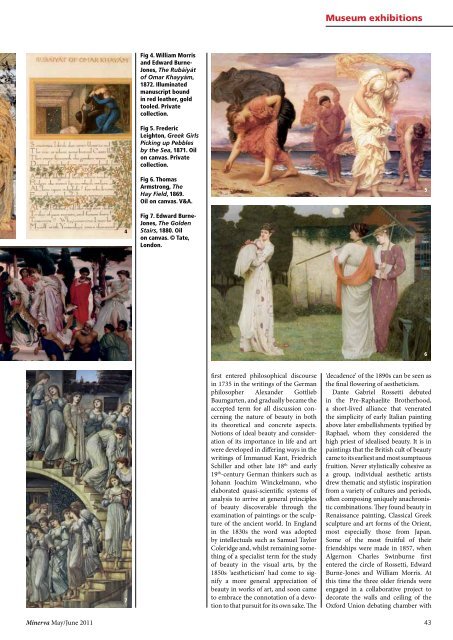Cult of beauty - Minerva
Cult of beauty - Minerva
Cult of beauty - Minerva
Create successful ePaper yourself
Turn your PDF publications into a flip-book with our unique Google optimized e-Paper software.
<strong>Minerva</strong> May/June 2011<br />
4<br />
7<br />
Fig 4. William Morris<br />
and Edward Burne-<br />
Jones, The Rubáiyát<br />
<strong>of</strong> Omar Khayyám,<br />
1872. Illuminated<br />
manuscript bound<br />
in red leather, gold<br />
tooled. Private<br />
collection.<br />
Fig 5. Frederic<br />
Leighton, Greek Girls<br />
Picking up Pebbles<br />
by the Sea, 1871. Oil<br />
on canvas. Private<br />
collection.<br />
Fig 6. Thomas<br />
Armstrong, The<br />
Hay Field, 1869.<br />
Oil on canvas. V&A.<br />
Fig 7. Edward Burne-<br />
Jones, The Golden<br />
Stairs, 1880. Oil<br />
on canvas. © Tate,<br />
London.<br />
first entered philosophical discourse<br />
in 1735 in the writings <strong>of</strong> the German<br />
philosopher Alexander Gottlieb<br />
Baumgarten, and gradually became the<br />
accepted term for all discussion concerning<br />
the nature <strong>of</strong> <strong>beauty</strong> in both<br />
its theoretical and concrete aspects.<br />
Notions <strong>of</strong> ideal <strong>beauty</strong> and consideration<br />
<strong>of</strong> its importance in life and art<br />
were developed in differing ways in the<br />
writings <strong>of</strong> Immanuel Kant, Friedrich<br />
Schiller and other late 18 th and early<br />
19 th -century German thinkers such as<br />
Johann Joachim Winckelmann, who<br />
elaborated quasi-scientific systems <strong>of</strong><br />
analysis to arrive at general principles<br />
<strong>of</strong> <strong>beauty</strong> discoverable through the<br />
examination <strong>of</strong> paintings or the sculpture<br />
<strong>of</strong> the ancient world. In England<br />
in the 1830s the word was adopted<br />
by intellectuals such as Samuel Taylor<br />
Coleridge and, whilst remaining something<br />
<strong>of</strong> a specialist term for the study<br />
<strong>of</strong> <strong>beauty</strong> in the visual arts, by the<br />
1850s ‘aestheticism’ had come to signify<br />
a more general appreciation <strong>of</strong><br />
<strong>beauty</strong> in works <strong>of</strong> art, and soon came<br />
to embrace the connotation <strong>of</strong> a devotion<br />
to that pursuit for its own sake. The<br />
Museum exhibitions<br />
‘decadence’ <strong>of</strong> the 1890s can be seen as<br />
the final flowering <strong>of</strong> aestheticism.<br />
Dante Gabriel Rossetti debuted<br />
in the Pre-Raphaelite Brotherhood,<br />
a short-lived alliance that venerated<br />
the simplicity <strong>of</strong> early Italian painting<br />
above later embellishments typified by<br />
Raphael, whom they considered the<br />
high priest <strong>of</strong> idealised <strong>beauty</strong>. It is in<br />
paintings that the British cult <strong>of</strong> <strong>beauty</strong><br />
came to its earliest and most sumptuous<br />
fruition. Never stylistically cohesive as<br />
a group, individual aesthetic artists<br />
drew thematic and stylistic inspiration<br />
from a variety <strong>of</strong> cultures and periods,<br />
<strong>of</strong>ten composing uniquely anachronistic<br />
combinations. They found <strong>beauty</strong> in<br />
Renaissance painting, Classical Greek<br />
sculpture and art forms <strong>of</strong> the Orient,<br />
most especially those from Japan.<br />
Some <strong>of</strong> the most fruitful <strong>of</strong> their<br />
friendships were made in 1857, when<br />
Algernon Charles Swinburne first<br />
entered the circle <strong>of</strong> Rossetti, Edward<br />
Burne-Jones and William Morris. At<br />
this time the three older friends were<br />
engaged in a collaborative project to<br />
decorate the walls and ceiling <strong>of</strong> the<br />
Oxford Union debating chamber with<br />
5<br />
6<br />
43

















